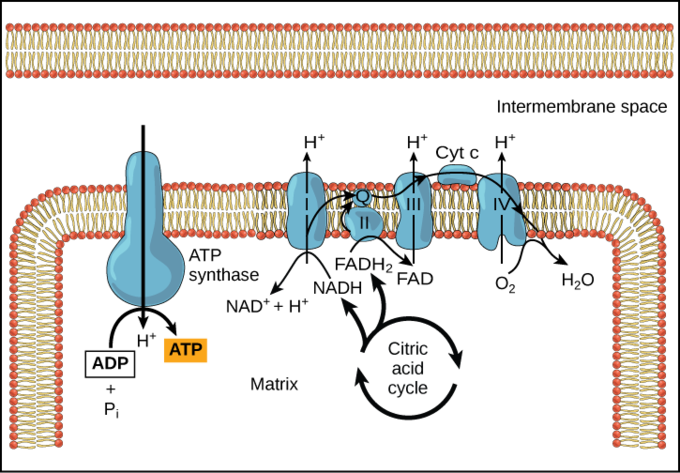Why Are Hydrogen Ions Important in Cellular Respiration
Cells in our body combine glucose and oxygen to make ATP and carbon dioxide. Why is it important for DNA to be.

7 4b Chemiosmosis And Oxidative Phosphorylation Biology Libretexts
Cellular respiration is the process cells use to make energy.
. When each FADH2 gives up electrons and hydrogen ions there is enough of a potential energy change to make two ATP molecules. Cells in our body combine glucose and oxygen to make ATP and carbon dioxide. It generates chemical gradients which have potential energy.
It produces oxygen gas which is essential to cell functions. The hydrogen atoms from substrate molecules are combined with coenzymes such as NAD. Oxygen combines with the electrons and two hydrogen ions to make water.
The free energy made available by the electron transport chain is used to move hydrogen ions H across the inner mitochondrial membrane creating a membrane potential that produces ATP as hydrogen ions H return across the membrane through ATP synthase in chemiosmosis. Choose the correct reactants and products. During cellular respiration in both mitochondria and aerobic prokaryotes the Electron Transport Chain pumps H ions out of the matrix or cytoplasm to create a H concentration gradient.
Metabolism means providing energy and providing energy means continuing life so cellular respiration is vital. The main function of the cellular respiration is hydrogen and its bonding electrons change partnersCarbohydrates fats and proteins are. The electron transport chain uses some of the energy from the high-energy electrons it passes to actively transport hydrogen ions H Which direction are H being transported via active transport.
It generates ATP which cells can use to do work. Cellular respiration is the process cells use to make energy. The process stops without oxygen.
This creates a proton gradient. It is important to know that during the electron transport chain when each NADH gives up electrons and hydrogen ions there is enough of a potential energy change to make three ATP molecules. The hydrogen ions and electrons are passed to the electron transport chain on the inner mitochondrial membrane.
Lastly the hydrogen ions flow through ATP synthase to make ATP. Oxygen combines with electrons and hydrogen ions to produce water. Oxygen combines with the electrons and two hydrogen ions to make water.
Whats the role of oxygen in cellular respiration. Electron transport chains ETC hydrogen ion pump e-s from NADH and FADH2 pass thru a series of acceptor molecules releasing e-s and hydrogen ions protons. Answer 1 of 3.
I was wondering however why the H ions are pumped out of the matrix or cytoplasm instead of. This process manufacture ATP ATP is one of the most important units of energy that cells release its energy to use whenever they need it. It breaks down carbon dioxide which is toxic to cells.
Electrons are usually the currency of chemical reactions. Cellular respiration can be summarized by a simple formula. In the case of respiration and photosynthesis electrons are ejected from donors - light-activated chlorphyll in the case of a photosynthesis and NADH.
Quick and dirty answer. The released energy is used to pump the H ions thru the inner membrane and into the inter membrane space against the concentration gradient. It accepts electrons and keeps the electron transport chain running.
This occurs in both glycolysis and the citric acid cycle. Cellular respiration is part of the metabolism in living things including humans. There are two important electronhydrogen carriers in cellular respiration nicotinamide adenine dinucleotide abbreviated as NAD in its oxidized form and flavin adenine dinucleotide abbreviated as FAD in its oxidized form.
It breaks down carbon-based sugar molecules to release energy and forms carbon dioxide. As electrons flow through the proteins they pump hydrogen ions into the intermembrane space creating an electrochemical gradient. It combines with hydrogen ions in sugar molecules to release energy and form water.
Oxygen serves as a final electron acceptor of the electron transport chain in cellular respiration assisting the movement of electrons down a chain resulting in the production of adenosine triphosphate ATP. Lastly the hydrogen ions flow through ATP synthase to make ATP. This forces the H ions back into the matrix or cytoplasm forcing ATP synthase into action.

The Electron Transport Chain Advanced Read Biology Ck 12 Foundation
2 29 Electron Transport Biology Libretexts

Where Do The Hydrogen Ions End Up In Cellular Respiration Quora
No comments for "Why Are Hydrogen Ions Important in Cellular Respiration"
Post a Comment